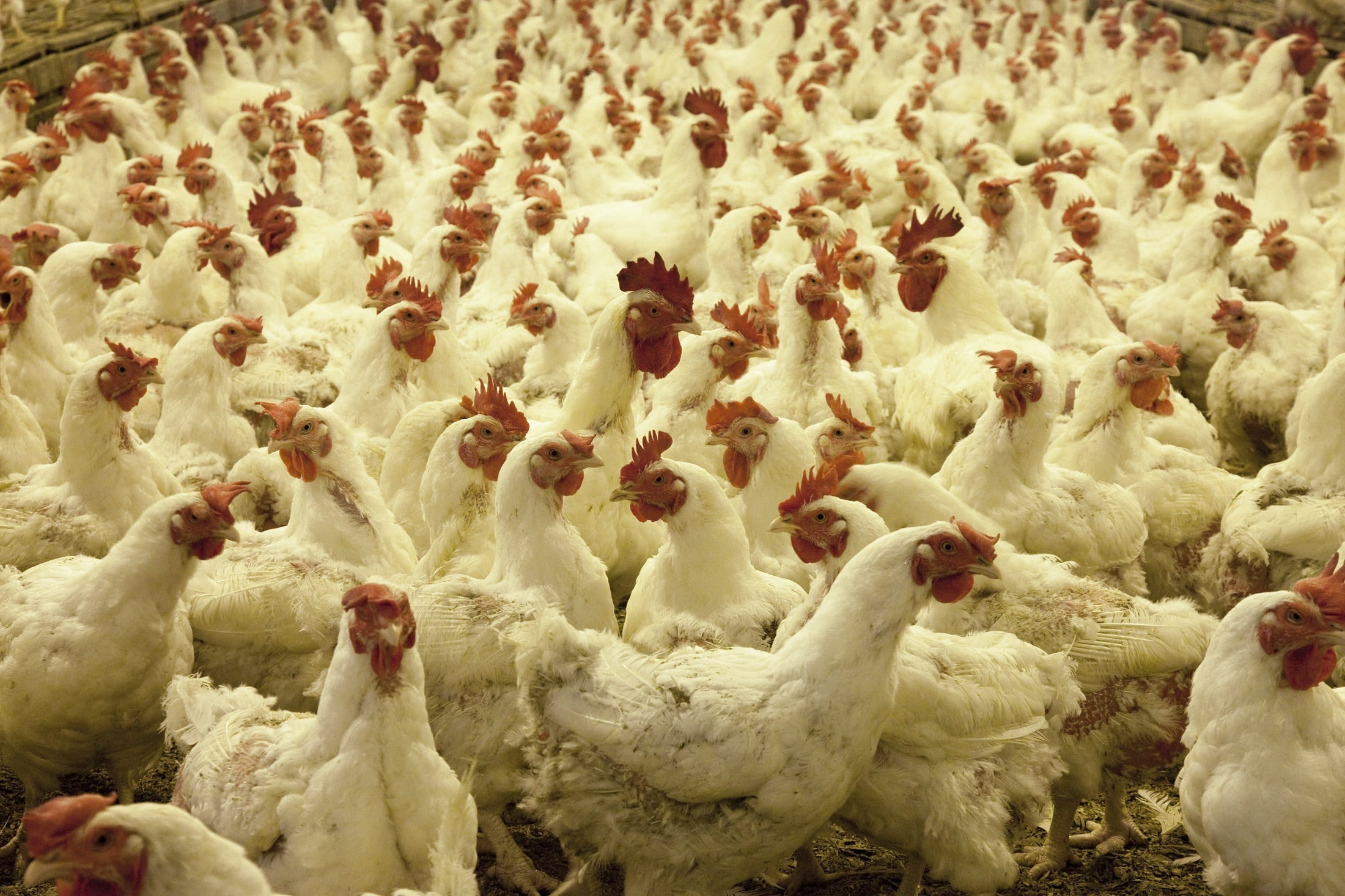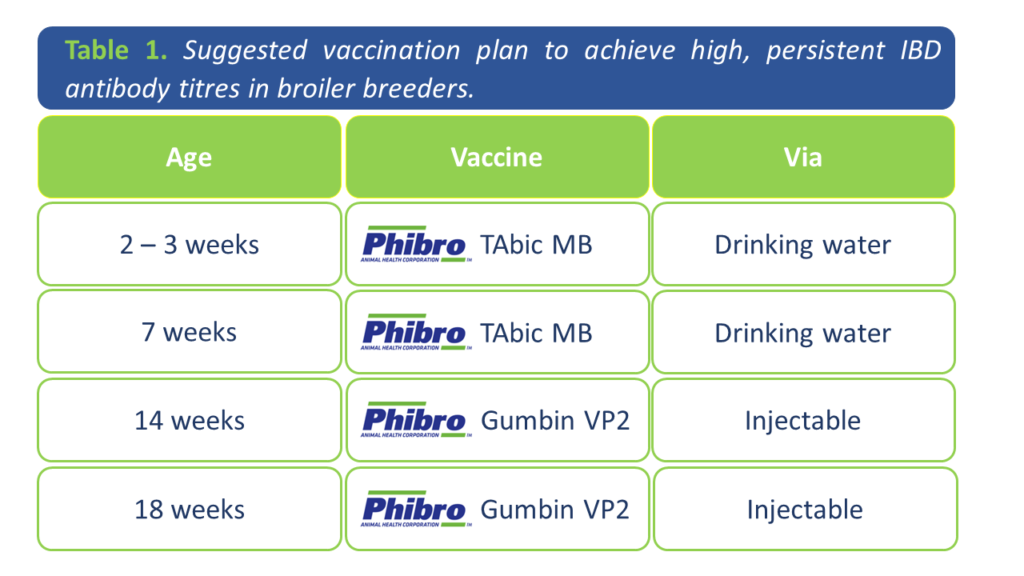In our previous two articles (ProAgri Zambia 71 and 73), we have described the basis of Infectious Bursal Disease (IBD) (or Gumboro Disease), the dynamics of antibodies in chickens, as well as the properties on Phibro’s MB vaccine strain.
In this third article, we discuss five important tips to achieve successful immunisation against IBD. You may discuss them with your veterinary consultant and find the best way to implement them at your enterprise.
Tip 1: Ensure good levels of antibodies in broiler breeder flocks
As discussed in our previous articles, hens transfer protection against IBD to the chicks in the form of maternal derived antibodies (MDAs) through the yolk. MDAs neutralise field viruses, stopping them from reaching and infecting the bursa of fabricius (target organ of this virus). MDAs also can neutralise vaccine viruses when applied at wrong times, resulting in vaccination failure. Solutions to this issue are discussed later in this article. The MDAs titre of each chick at hatching determines the moment at which it will become susceptible to infection by field strains, as well as the time at which the bird should be vaccinated.
Such a level of MDAs is directly related to the levels of circulating antibodies in the breeder hens. To obtain high, persistent titres of antibodies against IBD in broiler breeders, they should be hyperimmunised during rearing by following a vaccination plan consisting of, at least two live vaccines, followed by two inactivated vaccines. An example is shown in table 1.
Tip 2: Use a vaccine strain similar to the circulating field strains in your area
In issue 71 of ProAgri, we published a graph representing the dynamics of MDAs in broiler chickens (Figure 1). After day 4 of life, there is a progressive reduction of MDAs. The persistence of MDAs in chicks will depend on their titres at hatching. As the decline in MDAs progresses, vaccine strains and field strains begin to escape the neutralising effect of the MDAs at different times; the concentration of MDAs at which they can escape neutralisation is called breakthrough titre, and it is characteristic for each strain.
Once the breakthrough titre is reached, the virus (vaccine or field strain) can move to the bursa and multiply. As we discussed in issue 71 of ProAgri, once an IBD virus reaches the bursa, it colonises it and no other strain (neither vaccine, nor field strain) can enter after that. In Zambia, very virulent IBDV field strains are the most commonly circulating strains. They have high breakthrough titres, so they can reach the bursa very early and produce infection.
Therefore, a successful vaccination programme requires the introduction of a vaccine strain that can also reach the bursa early, such as the MB strain. MB has very high breakthrough titre (800 IDEXX ELISA) that allows it to enter the bursa much earlier than other commonly used IBD vaccines, which explains why it is so successful in controlling IBD in Zambia.

Figure 1: IBD antibody dynamics in chicks, showing the moment in which vaccine is able to escape neutralisation by MDAs (maternal derived antibodies)
Tip 3: Decide the number and time of vaccination(s) based on the MDAs titre
A factor to consider when planning the date(s) and number of vaccination(s) against IBD is the breakthrough titre of the vaccine. Vaccinating the birds before they reach the vaccine breakthrough titre will result in the vaccine being neutralised by the MDAs and wasted. If the vaccine is given too late, then it is likely that the field strain will reach the bursa before the vaccine, resulting in infection.
A second factor is the level of MDAs at hatch. The lower that level is, the earlier the chicks become susceptible to infection, and the earlier they need to be vaccinated. At the same time, less uniform titres of MDAs in a broiler flock may result in the need of vaccinating the flock more than once. The ideal moment of vaccination can be estimated by using the Deventer formula. Based on the blood MDAs titres, measured by serology within the first 4 days of life, this formula estimates a first date of vaccination (aiming to protect the 25% of the birds that reach the breakthrough titre for the vaccine earlier), and a second date, aiming to protect the 75% of the flock.
When the estimated dates of vaccination are very close to each other, the farmer may be able to successfully control IBD with only one vaccination. However, when the MDAs titres in a flock are very variable between chicks, two vaccinations may be needed, depending on the vaccines used. Since MB can be applied much earlier than other vaccines and can spread from bird to bird very successfully, we find that, in most cases, a single vaccination is sufficient to provide solid protection. In any case, consult your veterinarian regarding the on-farm schedule of MB vaccinations.
If Day Old hatchery vaccine injection is done, MB-1 (the MB vaccine formulated for in-ovo and hatchery application) can simplify your vaccination programme, because the vaccine virus is released in the individual birds according to their MDA levels resulting in tailor-made protection. You can find more information on MB-1 in our article in Issue 73 of ProAgri Zambia.
Tip 4: Is it better to combine different vaccines in your programme or just use one strain?
The theory behind combining different vaccines is that you use a vaccine with a high MDA breakthrough titre at an early age to allow for birds with lower MDA levels to be immunised and give a milder vaccine at a later age (when MDA levels are low) to immunise the rest of the birds in the flock.
A second argument for this approach is that a “hotter” vaccine strain may damage the bursa in birds with low MDAs and that this may lead to immune suppression, whereas the milder vaccines do not cause any significant bursa damage so they can be used to immunise the birds when they are older and have no MDAs. The problem with this approach is that it tends to leave many birds open to challenge by the field strains in the period between the two vaccinations.
If the Deventer formula indicates that two vaccinations will be required, it will be more effective to use two doses of a vaccine like MB because it can be given early, it can spread from immunised birds to other birds as their MDA levels drop, and the fact that it will not cause any immune suppression in birds with very low MDA levels.
Tip 5: Verify the success of your IBD vaccination programme
The quickest and easiest way to verify the efficacy of your IBD vaccination programme is to check what IBD strain is present in the bursa of the birds by means of PCR testing of the bursa, either from samples taken on farm or at the abattoir. As mentioned above, the arrival and multiplication of a virus (vaccine or field strain) in the bursa excludes the entry of other viruses.
Therefore, if PCR analysis of the bursa detects only vaccine strain (and no clinical signs of IBD are observed) it can be said the vaccination programme is working. However, if only the field strain is detected, then the programme needs to be re-evaluated. It is also important to note, though, that no vaccine will ever be 100% effective.
Therefore, there is always a possibility that field strain may be detected, even when using a vaccine like MB in your programme. The presence of field strain could be due to vaccination timing or application issues. Ongoing field monitoring shows that the incidence of field strains is below 10% in programmes using MB or MB-1, compared to almost 80% when using some of the milder vaccines.










